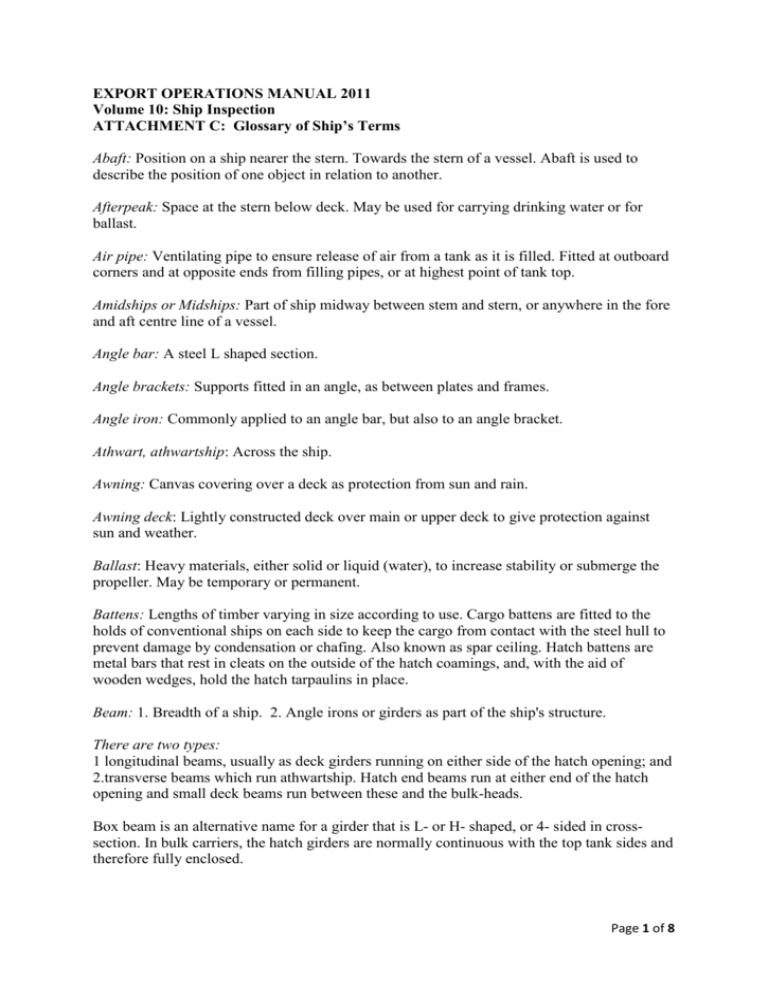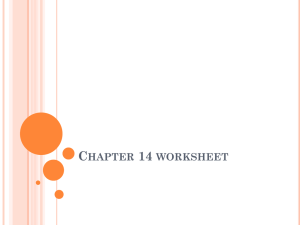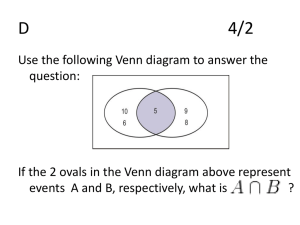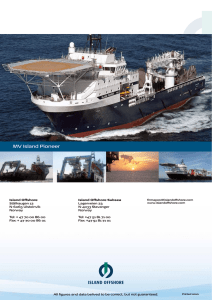EXPORT OPERATIONS MANUAL 2011 Volume 10: Ship Inspection
advertisement

EXPORT OPERATIONS MANUAL 2011 Volume 10: Ship Inspection ATTACHMENT C: Glossary of Ship’s Terms Abaft: Position on a ship nearer the stern. Towards the stern of a vessel. Abaft is used to describe the position of one object in relation to another. Afterpeak: Space at the stern below deck. May be used for carrying drinking water or for ballast. Air pipe: Ventilating pipe to ensure release of air from a tank as it is filled. Fitted at outboard corners and at opposite ends from filling pipes, or at highest point of tank top. Amidships or Midships: Part of ship midway between stem and stern, or anywhere in the fore and aft centre line of a vessel. Angle bar: A steel L shaped section. Angle brackets: Supports fitted in an angle, as between plates and frames. Angle iron: Commonly applied to an angle bar, but also to an angle bracket. Athwart, athwartship: Across the ship. Awning: Canvas covering over a deck as protection from sun and rain. Awning deck: Lightly constructed deck over main or upper deck to give protection against sun and weather. Ballast: Heavy materials, either solid or liquid (water), to increase stability or submerge the propeller. May be temporary or permanent. Battens: Lengths of timber varying in size according to use. Cargo battens are fitted to the holds of conventional ships on each side to keep the cargo from contact with the steel hull to prevent damage by condensation or chafing. Also known as spar ceiling. Hatch battens are metal bars that rest in cleats on the outside of the hatch coamings, and, with the aid of wooden wedges, hold the hatch tarpaulins in place. Beam: 1. Breadth of a ship. 2. Angle irons or girders as part of the ship's structure. There are two types: 1 longitudinal beams, usually as deck girders running on either side of the hatch opening; and 2.transverse beams which run athwartship. Hatch end beams run at either end of the hatch opening and small deck beams run between these and the bulk-heads. Box beam is an alternative name for a girder that is L- or H- shaped, or 4- sided in crosssection. In bulk carriers, the hatch girders are normally continuous with the top tank sides and therefore fully enclosed. Page 1 of 8 Beam knees: The brackets attaching the beams to the frames. Alternatively referred to as elbows when in the upper parts of the holds. Bilge: 1. Curve of the hull where the vertical side meets the bottom. Applies to both the inside and outside of the hull. 2. Water, oil etc. accumulated in the bilges. Bilges: The space inside the hull that serves as a drainage area into which accumulated water can run and be pumped out. In bulk carriers where the tank top extends out into the ship's side there are no proper bilges. Holds drain into sunken compartments in the double botton known as wells. They are placed in each wing. Bilge keelson: Internal plates fitted longitudinally between frames along the line of the bilge in ships having no double bottom tanks. Bilge pipes: Pipes fitted throughout the length of the ship for draining the bilges. The suction end of each pipe is fitted with a strum box to act as a filter. Bilge pump: Pump for extracting water from the bilges and discharging it overboard. Bitts: Iron posts on a metal base on deck to which mooring ropes are secured. (Bollards are similar structures ashore). Boatswain (pron. bosun): A seaman working under the command of the chief officer and to whom he is responsible for the deckhands. Boom: Beam of wood or steel used as a derrick. Bow: Fore part of the ship immediately abaft the stem. Bow locker: Compartment under forecastle head, usually a store for equipment. Breakwater: Barrier across forecastle head to check the force of water breaking over the bows in bad weather. Bulb angle: Angle bar with one edge thickened in a semi circular form. Bulkhead: A vertical partition to provide compartments or subdivisions. May be either transverse or fore and aft. Where planks are fixed to a bulkhead, this may be described as bulkhead sheathing or timber bulkhead. Bulwarks: Planking at edges of main deck for protection against high seas. Bunker: Compartment where fuel for ship's engines is stored. Cable casings: Casings that protect electrical cables in the holds. Located under the upper deck in conventional vessels and in pipes on deck or inside the top wing tanks in bulk carriers. Page 2 of 8 Ceiling: Planking that sheaths plating; normally used only for timber in holds for example, tank top ceiling, bilge ceiling and spar ceiling. Chain locker: Space in the bows where the anchor cable is housed. Channel: Rolled steel section or girder forming three sides of a rectangle. Cleats: 1. Fitting of two projecting horns attached to a base fixed in the centre and used for securing ropes. 2. Projection on a hatch coaming into which a wedge is driven to secure the hatch cover tarpaulins. 3. On Patent (McGregor) hatch covers, fittings on the side of the sections that pull the covers down onto the rubber seal. Clevis: A U-shaped iron at the end of a beam for supporting tackle. Coaming: A raised vertical boundary around hatches or other openings in a deck to keep out water. Raised sill at doors that open onto the weather deck. Hatch coamings provide support for hatches and have fittings to hold the hatch covers in place. Cotter dam: A narrow space between two watertight or oil-tight bulk- heads, usually provided for isolation purposes. Regarded as hazardous places and electric lighting and machinery usually prohibited from them. Corrugated bulkheads: In modern ships, bulkheads are often corrugated to give stiffness, so ordinary welded stiffeners are not fitted. Cowl: Hood-shaped fitting over a ventilating shaft or duct to direct the air-stream. Cradle: A staging that is suspended over the ship's side when painting or carrying out repairs. Deck: Flooring above the ship's bottom plating or double bottom. Deck beam: Horizontal beam placed athwartship to support a deck and provide a bracing for the sides of the hull. Deck girders: Usually fitted in line with the hatch coamings, and the coaming plate is then built into the girder. Deckhead: The underside of any deck. Deeptanks: Normally separate compartments in one or two hatches in the midship area and constructed for carrying liquids. Also used for ballast when the ship is empty. Degaussing: A method of protecting against magnetic mines consisting of an electric cable encircling the hull. When alternating current is circulated, the electromagnetic effect neutralises the residual magnetism of the steel structure. Hence, degaussing casings. Page 3 of 8 Derrick: Boom or spar, pivoted at one end, and used for handling cargo. Wire ropes from a winch run to the top of the derrick and then to the loading hook. The pivoted end may be attached to a platform on the deck or to a mast. Derrick post: Mast, king post or Sampson post from which the derrick is swung. Double bottom: Space between the double plating at the bottom of a ship. Sectionalised into separate tanks. Dunnage: Materials, either permanent or temporary, used to facilitate good storage and to protect cargo. Blocks, boards, paper, burlap etc. Feeder: A vertical trunk fitted temporarily in the hatchway of a hold carrying grain. It holds a percentage of the total grain which it feeds into the hold as the grain settles in transit. Forecastle, fo'c's'le: Raised part of the upper deck forward of the holds. Usually comprises lockers, workshop and gear storage for example, bosun's store. Forepeak: The angle of the bows. In older vessels, divided off from the hold to form, below the forecastle, forepeak lockers and tank. Forward, for'ard: In the direction of the bows. Frames: Steel ribs or girders extending vertically on the inside of the hull to give strength and rigidity to the structure. Frame spacing: Distance between the centre lines of adjacent frames. Galley: Kitchen - the place equipped and reserved for cooking. Girder: Beam of H-section. May be of rolled steel or build up by welding or riveting. When built may have a double H- construction. Gooseneck: Bend at the top of a pipe. Grab: Steel bucket with hinged jaws for loading and discharging grain, ore and chemical cargoes. Gunwale, (pron. gunnel): Upper edge of a ship's side next to the bulwark. Gutter: Channel on each side of the deck into which water drains, and then via the scuppers to the sea. Hatch: The opening in a deck giving access to a space below or to a hold. Hatches: Wooden planks or metal sections used to cover a hatch. The word 'hatch' is commonly applied to the entire space beneath a hatchway in the upper deck and therefore includes 'tween decks and lower hold. Hatch beam: Removable transverse beam supporting the hatch boards or pontoons. Page 4 of 8 Hatch beam carriers: Brackets on the inside of the hatch coamings that receive the beam ends. Hatch coaming: Strictly the raised portion or rim around the periphery of a hatchway, but may also include portions of the deck girders and hatch end beams that form the rim below the deck level. Hatch covers: 1. Tarpaulins fitted over the hatches and secured in position by steel bars and wooden wedges. 2. Steel covers in one piece or in sections. Hold: Internal compartment where cargo can be stowed and carried. One of the spaces between bulkheads specifically intended for carrying cargo. The term 'hold' can refer to spaces within a hatch for example, the lower hold or 'tween deck space. Hold pillars: Vertical columns from the deck of a hold to a beam at the deckhead. Hold stringers: Horizontal girders fitted at the sides of a hold for additional strength and rigidity. Hull: Outside plated frame and body of a ship. Inner bottom: Tank top. Jib: Derrick. Keelson: Girder construction extending the keel vertically inside the ship for her complete length, and forming an inner keel. Knee bracket: See beam knees. King post: Vertical post taking the strain of a jib or derrick, and may also serve as a ventilator. Alternatively known as a Sampson post. Limbers or limber boards: The wooden planks covering the bilges to prevent cargo from coming into contact with the water. In ships with steel bilge covers sheathed with planks, this timber is termed limber ceiling or bilge ceiling, and is fitted as protection for the plates. Lockers: Compartments fitted for storing and handling the ship's stores and equipment. McGregor hatch covers: See Patent hatch covers. Mast: Vertical tubular steel pole that carries derricks and other equipment. Masthouse: Superstructure between the hatches often enclosing hold access hatchways and switchgear. Main deck: Principal deck or'strength deck' - the deck that for structural reasons is an essential part of the hull. Page 5 of 8 Main hatch: In older vessels, the principal hatch where the heavies cargo was usually carried. The ship's official number and registered tonnage are cut into the coaming. Margin plates: Plating forming the sides of the double bottom tanks. Middle line longitudinal bulkheads: Partial longitudinal bulkheads fitted in lieu of pillars. Patent: Self-supporting covers in sections that when opened roll Hatch covers: along the coamings and are stowed upright in concertina fashion forward or aft of the hatch. Peaktank: A ballast tank at the after peak or forepeak. Pillars: See Hold pillars. Pontoon: 1. Floating platform for working on the side of a ship. 2. Type of steel hatch cover in the form of a fully or partly enclosed box and usually self-supporting. Poop: Short raised deck at the aftermost part of a ship. Port: Left hand side of the ship when looking forward. Pratique: Permission for persons to board and go ashore, given by port doctor after medical inspection has been carried out. Quarantine flag: A ship thought to be free of infectious disease flies a square yellow flag when arriving, and this is hauled down when she has been given pratique. If infectious diseases are suspected, two yellow flags are flown, but if confirmed the signal flags GL are shown. Rib: Equivalent in a wooden ship to the frame of a steel vessel. Scupper: Hole in the bulwarks to allow water on deck to flow over- board. Scuppers from decks below the freeboard deck may lead to the bilges. Shaft tunnel: Enclosed space from engine room to stern tube taking the prop shaft. Shedder plates: Vertically SIOPing plates fitted over coaming beams and girders, or other hold structures, to permit self cleaning of bulk cargoes. May also refer to large angle brackets designed to shed loose material. Shell: Outer plating of a ship. Shelter deck: Correctly the deck above the main deck. In ships with hatches divided into three, the upper space is usually referred to as the shelter deck or upper 'tween deck. Page 6 of 8 Shifting boards: These are located longitudinally along the mid line of the ship and are to prevent the movement of cargo in bad weather. In 1960 the safety regulations were changed to allow the use of saucers of bagged cargo instead of shifting boards. Shoe: Base piece in which a derrick rests. Shores: Wooden struts or planking fitted from the hull to the shifting boards or feeders to keep them in place. Sounding pipes: Vertical pipes from deck to tanks or bilges into which a graduated rod can be lowered to measure the depth of liquid in the compartment. Spar: A long round piece of timber. A general term for masts, booms etc. Spar ceiling: See battens. Also called sparring. Sparring cleats: As in cleats 2. Stage: Platform lowered on ropes over side of ship or in holds for painting and other work. Stanchion: Vertical beam or pillar used as a support, or to strengthen a deck above. Starboard: Right hand side of ship when facing forward. Stern: After end of ship. Stiffeners: Large areas of plating usually supported by angle bars or channels to add stiffness for example, Patent hatch covers, bulkheads. Strum box: Metal box with perforated sides placed around the end of a bilge suction pipe. Super-structure: Term applied to structures above the main deck-bridge, cabins, storerooms, etc. Table: Athwartship platform on each side of mast to take the heels of cargo derricks. Tanktop: The top plating of a ship's double bottom. Tonnage opening: Well in uppermost deck of a shelter deck ship having only temporary means of closing. This arrangement was intended to obtain exemption from inclusion in tonnage measurements for relevant space between shelter deck and upperdeck. 'Tween decks: More correctly the between decks. In a cargo ship, any deck between the tank top and the main deck, and the space between it and the deck above. Upperdeck: Topmost continuous deck where there is more than one continuous deck. Ventilator: Device for removing air or delivering it to a hold. A cowl on the exposed top controls intake or exhaust, as required. Water ballast: Seawater taken on, usually in the double and the deep and peak tanks. Page 7 of 8 Weather deck: Exposed deck open to the elements. Web frames: Larger frames of T-section spaced at intervals, and often with smaller frames between. Double built web frames are an arrangement of two web frames placed side by side and joined by several horizontal plates. Wedges: On older vessels, wooden pieces to fit into the cleats for securing the hatch tarpaulins. On Patent hatch covers, wedges, when fitted, bridge the edges of the sections and hold them down in conjunction with the cleats. Wells: Bilges in bulk carriers where the double botton tanks extend to the sides of the hold. They are in both wings. Wind chute: Same as ventilator cowl. Page 8 of 8









